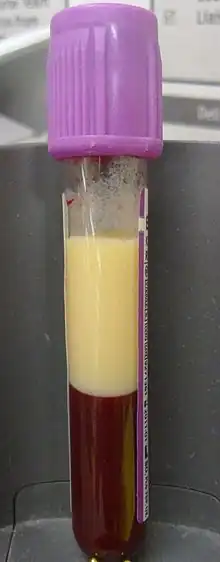Dyslipidemia
| Dyslipidemia | |
|---|---|
 | |
| Yellowish patch consisting of cholesterol above the eyelids. These are more common in people with familial hypercholesterolemia. | |
| Specialty | Cardiology |
| Symptoms | None, yellowish lipid deposits in the skin[1][2] |
| Complications | Heart disease, stroke, pancreatitis[1][2] |
| Types | Phenotype I, IIa, IIb, III, IV, V[1] |
| Risk factors | Genetics, poor diet, inactivity, obesity, smoking, diabetes, nephrotic syndrome, biliary obstruction, hypothyroidism, certain medications[1][2] |
| Diagnostic method | Blood tests for total, LDL, and HDL cholesterol, and triglycerides[1] |
| Treatment | Lifestyle changes, medications[1] |
| Frequency | Common[1] |
Dyslipidemia is an abnormal amount of lipids (fats) in the blood.[1] It is divided into six types which result in some combination of high total cholesterol, high LDL cholesterol, low HDL cholesterol, high triglycerides, or high apolipoprotein B.[1] There are generally no symptoms, though occasionally yellowish lipid deposits within the skin occur.[1][2] Complications may include heart disease, stroke, and pancreatitis.[1][2]
Causes may include poor diet, inactivity, obesity, excessive alcohol, and smoking.[1][2] Other health conditions that can result in dyslipiedmia include diabetes, nephrotic syndrome, biliary obstruction, hypothyroidism, and certain medications.[1][2] Some types run in families such as familial hypercholesterolemia.[1] Diagnosis is generally by blood tests for total, LDL, and HDL cholesterol, and triglycerides.[1]
Treatment involves lifestyle changes including a diet high in vegetables and exercise.[1] Other treatments depend in part on the types of dyslipidemia.[2] If medications are used, the initial choice is generally a statin.[1] Dyslipidemia becomes more common with age.[1] In the United States high cholesterol affects about 34% of those over the age of 20.[1]
Types
| Increases | Decreases | |
|---|---|---|
| Lipid |
|
|
| Lipoprotein |
|
|
| Both |
|
Diagnosis

Classification
Dyslipidemias are classified in two ways:
- Presentation in the body (including the specific type of lipid that is increased)
- Underlying cause for the condition (genetic, or another condition).[2] This classification can be problematic, because most conditions involve the intersection of genetics and lifestyle issues. However, there are a few well-defined genetic conditions that are usually easy to identify.
Fredrickson Classification:[3][1]
| Phenotype | I | IIa | IIb | III | IV | V |
|---|---|---|---|---|---|---|
| Elevated lipoprotein | Chylomicron | LDL | LDL and VLDL | IDL | VLDL | VLDL and chylomicrons |
Screening
Testing the general population under the age of 40 without symptoms is of unclear benefit.[4][5] Testing is not needed more often than every 10 years at most.[6] These can be done non fasting.[6]
Management
A Mediterranean diet and exercise is recommended.[6]
Medications
If medications are used the first line treatment is generally statins.[1] With statins, the goal is to increase the medication to a specific dose, rather than adjust the medication to a cholesterol level.[6]
Other medications that can be used include ezetimibe.[1] Fibrates may be used for high blood triglycerides.[2] When used together with statins they may cause muscle breakdown.[1]
References
- 1 2 3 4 5 6 7 8 9 10 11 12 13 14 15 16 17 18 19 20 21 22 23 Pappan, N; Rehman, A (January 2020). "Dyslipidemia". PMID 32809726.
{{cite journal}}: Cite journal requires|journal=(help) - 1 2 3 4 5 6 7 8 9 10 "Dyslipidemia - Endocrine and Metabolic Disorders". Merck Manuals Professional Edition. Archived from the original on 19 November 2020. Retrieved 20 November 2020.
- ↑ Fredrickson DS, Lees RS. A system for phenotyping hyperlipoproteinemia. Circulation 1965;31:321-327.
- ↑ Bibbins-Domingo, Kirsten; Grossman, David C.; Curry, Susan J.; Davidson, Karina W.; Epling, John W.; García, Francisco A. R.; Gillman, Matthew W.; Kemper, Alex R.; Krist, Alex H.; Kurth, Ann E.; Landefeld, C. Seth; Lefevre, Michael; Mangione, Carol M.; Owens, Douglas K.; Phillips, William R.; Phipps, Maureen G.; Pignone, Michael P.; Siu, Albert L.; Siu, A. L. (August 9, 2016). "Screening for Lipid Disorders in Children and Adolescents". JAMA. 316 (6): 625–33. doi:10.1001/jama.2016.9852. PMID 27532917.
- ↑ Chou, R; Dana, T; Blazina, I; Daeges, M; Bougatsos, C; Jeanne, TL (18 October 2016). "Screening for Dyslipidemia in Younger Adults: A Systematic Review for the U.S. Preventive Services Task Force". Annals of Internal Medicine. 165 (8): 560–564. doi:10.7326/m16-0946. PMID 27538032.
- 1 2 3 4 O'Malley, Patrick G.; Arnold, Michael J.; Kelley, Cathy; Spacek, Lance; Buelt, Andrew; Natarajan, Sundar; Donahue, Mark P.; Vagichev, Elena; Ballard-Hernandez, Jennifer; Logan, Amanda; Thomas, Lauren; Ritter, Joan; Neubauer, Brian E.; Downs, John R. (22 September 2020). "Management of Dyslipidemia for Cardiovascular Disease Risk Reduction: Synopsis of the 2020 Updated U.S. Department of Veterans Affairs and U.S. Department of Defense Clinical Practice Guideline". Annals of Internal Medicine. doi:10.7326/M20-4648.
External links
| Classification |
|---|